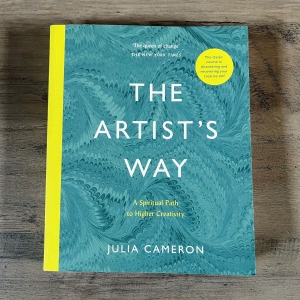
After the tribulations of week 4, weeks 5 and 6 moves into less difficult though still thought-provoking material as Cameron continues to unpack our negative conditioning when it comes to art. With week 4 being something of a turning point, Cameron digs deeper into her subject, making connections among her themes in a way that brings greater depth to the original material while relating it to topics under review.
Week 5: Recovering a Sense of Possibility
Limits and Possibilities
“What dream are you discounting as impossible given your resources?”
Week 5 investigates how our own thinking (the product of “negative patterning”) interferes with our creative life. In the Limits and Find the River, Cameron aims to change how we view our so-called limitations. She notes that we serve as gatekeepers to our artistic possibilities, because we assume there are limits to what we can accomplish. These beliefs may manifest as dismissing inspiration as overly impractical/ambitious or feelings guilty for the bounty we possess or receive.
Cameron indicates such beliefs may be shaped by scarcity thinking (more commonly called scarcity mindset or mentality). The Artist’s Way doesn’t explore this concept further, but I feel it is worth reviewing given the associated negatives. Scarcity mentality results from an excessive focus on what an individual lacks (typically, time, money or connection), which absorbs too much of their “mental bandwidth” and makes it difficult for them to make good choices (eg, eating healthier, exercise, and, here, delving into artistic interests). In Cameron’s eyes, however scarcity thinking causes blocked artists to view God/the universe as a “capricious parent figure”, effectively making the divine the scapegoat for our artistic underachieving.

Rejecting this notion, she suggests that we listen to our internal creative guide/intuition to find our path instead. Morning pages may be helpful here: Cameron recommends asking questions in the evening and listening for answers while writing on the following morning. However, we first need to believe that we can make progress towards our vision. Such progress occurs by continuing to work through artistic blocks, taking meaningful steps to achieve these goals (“doing the footwork”), and being open to opportunities from diverse sources.
Problematic “Virtue”
“The urge toward respectability and maturity can be stultifying, even fatal.”
Seemingly switching topics abruptly halfway through the chapter, Cameron revisits a theme first mentioned in week 2 (recovering a sense of identity). Week 2 largely focused on how others (fellow blocked creatives, crazymakers[*]) may fuel our self-doubt or otherwise sabotage our creative recovery and lead us into self-destructive behavior.[†] Reexamining this theme from the opposite viewpoint, this section looks at how “obligations” to others block artists creatively. The perhaps understated connection here is that this form of self-sabotage serves to limit to our artistic possibilities when we get caught up in “virtuous production”.
Cameron begins with observing that artists require both time and space alone to create and heal/recharge. After sharing some longish if relatable scenarios, she reveals that many of us prioritize the needs of others, giving up our time and/or money to satisfy their wants at tremendous personal and artistic cost. Dubbing this the virtue trap, Cameron claims we’re afraid to decline requests or prioritize our needs and desires because we enjoy our positive reputation.[‡] Referring back to week 2 reveals some likely reasons (eg, guilt at disappointing loved ones seemed to be spot on for me) as to why artists continue “making nice” instead of “nurturing” a “sense of self”. Also similar to week 2, Cameron’s “telling it as it is” approach here can seem harsh (she equivocates this behavior with embracing a “martyr’s cross”), but her concerns are valid ones. An important takeaway is that we need to consider whether our generous impulses are genuine or are rooted in feeling obliged.

Cameron doesn’t offer suggestions for negotiating with the people in our lives, although I imagine “the footwork” here may entail require some honesty about our needs, establishing boundaries and counselling for some. However, she recommends that we embrace our creativity, continue to discover who we truly are, and trust in God/the universe. The tasks for this week are designed to assess whether we’re caught in the virtue trap as well as help us suss out our personal desires, something Cameron believes will help remove barriers to investigating these interests. I would also add that embracing an abundance mindset, which dovetails with Cameron’s advice, might be useful as there are instances where real scarcity requires tradeoffs.
Week 6: Recovering a Sense of Abundance
Faith and Finances
“Creativity is not and never has been sensible.”
Week 6 builds off week 5’s examination of limitations, as it launches into a related (though meandering) conversation on issues surrounding finances. In The Great Creator, Cameron points out a panoply of negative ideas we have about the divine/higher power, money, work, virtue, and art. For example, money can be viewed as the only “true” source of security, the proverbial root of all evil, and a necessity that must be amassed in sufficient quantities before one can safely (if ever) practice art. By these standards, artistic pursuits seem foolish and likely to make our lives unpleasant as though we might be defying either God’s will or acting recklessly. Attributing such beliefs (much like week 5) to toxic ideas about God, Cameron recommends revising one’s concept of the divine in morning pages, an exercise that likely won’t appeal to some nonbelievers.
According to Cameron, our beliefs that we should be sensible (garnered from what others’ think “is sensible for us”) spurs us to be a “cheapskate” to ourselves while blaming the divine because we dismissed our opportunities. From her perspective, there’s little evidence that God/the universe or creativity is particularly sensible. Therefore, we should expect support from our higher power. Art, too, should involve enjoyment and generosity to ourselves in the form of breaks and treats, which in turn will helps us accept gifts from the God/the universe (as first suggested in week 3). Finally, we should pursue our interests as they are what we’re meant to do and doing what we’re intended to do will lead to us opportunities, money, and relationships. Here, Cameron seems to be making the case that abandoning our artistic dreams is the less practical choice.
Luxury
“Art requires us to empower ourselves with choice.”
Completing the week is Cameron’s discussion on luxury, which loosely continues her thoughts on artistic needs from week 5 (The Virtue Trap). Explaining that our ideas about money affect our ideas about creativity, she observes that we might blame our financial limitations when we feel blocked instead of realizing that we’re actually feeling powerless or constrained. Art, she explains, requires expansion and the belief that we have sufficient supply[§] from God/the creative force.

To experience this abundance, we should practice self-care (at a minimum) and pamper our inner artist child by indulging in what Cameron labels as authentic luxury. What constitutes self-care or luxury, of course, varies among individuals. But it’s less about lavish spending (as her case of the famous artist illustrates) and more about enjoying things that bring us joy. Cameron’s examples center on small, typically inexpensive luxuries like watercolors sets, fresh fruit, or a flower. Luxury, too, may represent time to relax and recharge or spend time with loved ones.
These examples also illustrate several ways in which we deny ourselves creative joys, such as undervaluing ourselves (one artist tellingly indicated her reasonably priced luxury was “more than I thought I was worth”), perfectionism, or feeling obliged to work when they have a moment to relax (a recipe for burnout, creative or otherwise). As “serious adults”, we’re likely to deliver “wet blanket messages” about how we “should be working” or how we should deny ourselves simple pleasures as they’re unnecessary or “silly”. But, as Cameron indicates, this is the entire point: “serious art is born from serious play”. The chapter closes with an accounting task, which should reveal whether our spending on ourselves matches our priorities.
Some Final Thoughts
“Pray to catch the bus, then run as fast as you can.”
Weeks 5 and 6 cover similar ground[**] in their discussions about our (often unconsciously held) beliefs that interfere with our creative lives. Strikingly though, I found it more helpful to embrace being more openminded about my artistic prospects when Cameron exposed how contradictory and conflicting (not to mention miserable) these so-called sensible beliefs can be than to lean more into spiritual dependence. Perhaps the reason why The Artist’s Way works for people regardless of their stance on spiritual matters relates to its ability to plainly show us what we need to consider (and reconsider) in our lives.
I found Cameron’s firm push towards some personal accountability in weeks 5 and 6 to be particularly vital, as we should be aware that we (not our circumstance or higher powers) get in our own way when we “responsibly” say no to ourselves and yes to obligations and hardship that we resent undertaking. Such accountability also necessitates voicing our needs to the people in our lives, as it’s unlikely that anyone else will say carve out free time for our artistic practice or notice we’re struggling if we say nothing.
Cameron’s more practical suggestions also provide solid advice. For example, she effectively recommends utilizing project management tactics (ie, breaking our artistic projects into manageable chunks) to work through our blocks or around our more immediate difficulties or limitations. With this approach, it seems less reasonable to dismiss a potentially intimidating project, because we genuinely don’t know what might be capable of achieving without giving it a trial. And, frankly, Cameron’s ideas that we should enjoy a creative life (sprinkled with rewards and rest) sounds far more appealing than the alternatives. Given that many of her ideas about adding enjoyment to our lives seem fairly attainable, one might argue that giving them a try would be the sensible thing to do.

NOTES:
[*] In week 2, Cameron states that our ongoing involvement with crazymakers occurs as an attempt to avoid a creative life (thusly using their abuser to block their creativity, the veracity of which depends on the situation) and claims that such blocked artists may be codependent. Codependency represents an unhealthy relationship dynamic in which one party is a giver and the other a taker, with varying causes. Since Cameron terms this abuse and mentions potentially abusive situations, it’s important to understand that some mental health professionals would not consider an abused individual to be codependent. The concept of codependency has evolved much since this book’s publication, which means Cameron’s discussion and advice may not be current. For those experiencing abuse (US), you can contact the National Domestic Violence Hotline (https://www.thehotline.org/) for assistance.
[†] This term, first used week 2, likely should have been defined there, as I took it to mean some more obvious forms of self-destruction (eg, self-harm, substance abuse) versus the subtler ones (eg, clinging to relationships with a disinterested partner, maladaptive behaviors like avoidance and procrastination) eluded to here in week 5.
[‡] For anyone interested in nuance here, “positive reputation” applies both to situations where an individual is praised for their (reluctant) deeds and to situations where their actions let them escape criticism because they choose to meet others’/societal expectations. In the latter scenario, praise tends to be in short supply (people assume your generosity constitutes a duty or feel entitled to your assistance) but criticism is quick to follow should you buck conventions.
[§] This term is not specifically explained, but in the context of week 5 it refers to artistic inspiration, friends, lovers, homes, etc.
[**] Understandably, there’s some overlap as week 6 is a more in-depth discussion of a specific limit (finances). In fairness, though, Cameron’s discursive presentation may bear some responsibility, too.

